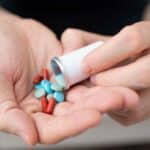If you take Desoxyn in high doses or abuse it over a long period of time, your body can become dependent on the drug. Once you become dependent on it, if you try to quit, uncomfortable withdrawal symptoms and side effects can occur.
Desoxyn is the brand name for the prescription form of methamphetamine or methamphetamine hydrochloride. Getting a prescription for Desoxyn is the only legal way to obtain methamphetamine in the US.
Desoxyn is used to treat attention-deficit hyperactivity disorder (ADHD) in children 6 years and up and occasionally obesity in adolescents and adults as it can lead to short-term weight loss.
It’s also considered a central nervous system (CNS) stimulant drug. It works by increasing the amount of the neurotransmitters dopamine and norepinephrine in the brain. It’s similar to an amphetamine like Adderall.
Desoxyn Withdrawal Symptoms
Desoxyn is classified as a schedule II controlled substance by the Food and Drug Administration (FDA) and the Drug Enforcement Administration (DEA). This means it has a high potential for abuse and dependence.
If you participate in Desoxyn abuse for a long period of time, stopping use becomes more difficult because of the potential for withdrawal symptoms, which may include:
- depression
- increased heart rate
- extreme fatigue
- dry mouth
- nausea/vomiting
- constipation
- stomach pain
- dehydration
- increased appetite
- sleep problems
- intense cravings
- anxiety and irritability
- poor memory
- paranoia and hallucinations
Desoxyn Withdrawal Timeline
The withdrawal timeline for this prescription drug can depend on a number of factors including the dose you’ve taken, how long you’ve taken the drug, and how it was administered (oral, snorting, smoking, etc).
In general, Desoxyn withdrawal can last anywhere from a few weeks to a couple of months.
24 Hours After Last Dose (Crash)
Withdrawal symptoms can begin to show up within the first 24 hours after your last dose.
This period of time is also referred to as a “crash” or “comedown” and can include symptoms like anxiety, agitation, drug cravings, memory issues, fatigue, paranoia, depression, and low energy. You may also experience insomnia or an increase in sleep.
7-14 Days
While withdrawal symptoms may start to subside during this period, some symptoms may become more intense. You may experience increased fatigue, slowed thinking, increased appetite, anxiety, mood swings, psychosis, suicidal thoughts, and depression.
Relapse is most likely to occur during this stage.
6+ Months (PAWS)
You may also experience post-acute withdrawal symptoms (PAWS). This can include anxiety, cravings, depression, fatigue, and mood swings. It can last 6 months or more. You may want to talk to your healthcare provider if you are still experiencing withdrawal symptoms at this stage.
Desoxyn Detoxification
Stopping Desoxyn on your own is not recommended because of how serious the effects of Desoxyn withdrawal symptoms can be. Entering a detox program can ensure you come down from the drug in a safe and medically supervised environment.
Some medications, including antidepressants, may be prescribed when detoxing from Desoxyn to make the withdrawal process more bearable and prepare you for the next step in treatment.
After detox, and especially if you live with Desoxyn addiction or substance use disorder, you’ll likely enter an inpatient or outpatient addiction treatment center. These rehab centers address both addiction and mental health with clinical services like behavioral therapy.
To learn if our outpatient substance abuse treatment programs are a good fit for yourself or a loved one, please contact us today.
Sources
Written by
Northeast Addition Editorial Team
©2024 Northeast Addition Center | All Rights Reserved
This page does not provide medical advice.



